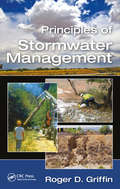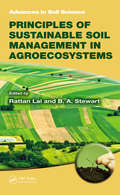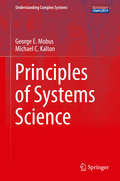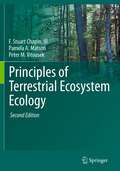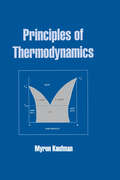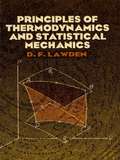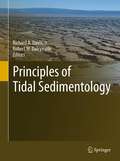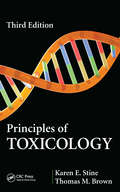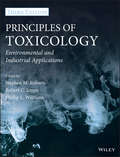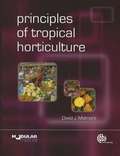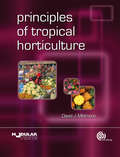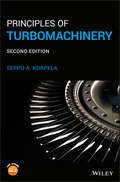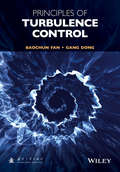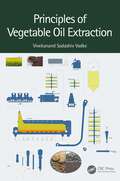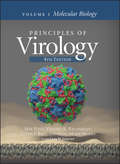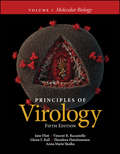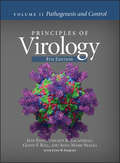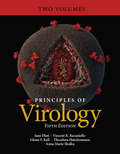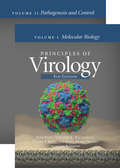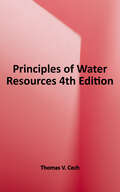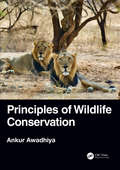- Table View
- List View
Principles of Stormwater Management
by Roger D. GriffinThis book presents of all aspects of storm water management: the hydrologic cycle, sources of contaminants, standards applicable to discharges, regulatory issues, atmospheric deposition, best management practices, and health/environmental impacts. It includes technical details of the modern treatment of stormwater, the emerging issues of atmospheric deposition, run-on, and snow melt, the Epidemiologic Model, and field data on discharge concentrations of a variety of contaminants. The principles explained in this book will enable students, contractors, developers, and engineers to grasp the most important field elements which must be included for construction projects impacting stormwater.
Principles of Sustainable Soil Management in Agroecosystems (ISSN)
by Rattan Lal B. A. StewartWith the use of high-level soil management technology, Africa could feed several billion people, yet food production has generally stagnated since the 1960s. No matter how powerful the seed technology, the seedling emerging from it can flourish only in a healthy soil. Accordingly, crop yields in Africa, South Asia, and the Caribbean could be double
Principles of Systems Science
by Michael C. Kalton George E. MobusThis pioneering text provides a comprehensive introduction to systems structure, function, and modeling as applied in all fields of science and engineering. Systems understanding is increasingly recognized as a key to a more holistic education and greater problem solving skills, and is also reflected in the trend toward interdisciplinary approaches to research on complex phenomena. While the concepts and components of systems science will continue to be distributed throughout the various disciplines, undergraduate degree programs in systems science are also being developed, including at the authors' own institutions. However, the subject is approached, systems science as a basis for understanding the components and drivers of phenomena at all scales should be viewed with the same importance as a traditional liberal arts education. Principles of Systems Science contains many graphs, illustrations, side bars, examples, and problems to enhance understanding. From basic principles of organization, complexity, abstract representations, and behavior (dynamics) to deeper aspects such as the relations between information, knowledge, computation, and system control, to higher order aspects such as auto-organization, emergence and evolution, the book provides an integrated perspective on the comprehensive nature of systems. It ends with practical aspects such as systems analysis, computer modeling, and systems engineering that demonstrate how the knowledge of systems can be used to solve problems in the real world. Each chapter is broken into parts beginning with qualitative descriptions that stand alone for students who have taken intermediate algebra. The second part presents quantitative descriptions that are based on pre-calculus and advanced algebra, providing a more formal treatment for students who have the necessary mathematical background. Numerous examples of systems from every realm of life, including the physical and biological sciences, humanities, social sciences, engineering, pre-med and pre-law, are based on the fundamental systems concepts of boundaries, components as subsystems, processes as flows of materials, energy, and messages, work accomplished, functions performed, hierarchical structures, and more. Understanding these basics enables further understanding both of how systems endure and how they may become increasingly complex and exhibit new properties or characteristics. Serves as a textbook for teaching systems fundamentals in any discipline or for use in an introductory course in systems science degree programs Addresses a wide range of audiences with different levels of mathematical sophistication Includes open-ended questions in special boxes intended to stimulate integrated thinking and class discussion Describes numerous examples of systems in science and society Captures the trend towards interdisciplinary research and problem solving
Principles of Terrestrial Ecosystem Ecology
by M. C. Chapin F. Stuart Chapin III Pamela A. Matson Peter M. VitousekFeatures review questions at the end of each chapter; Includes suggestions for recommended reading; Provides a glossary of ecological terms; Has a wide audience as a textbook for advanced undergraduate students, graduate students and as a reference for practicing scientists from a wide array of disciplines
Principles of Thermodynamics
by Jean-Philippe Ansermet Sylvain D. BrechetIn this introductory textbook, thermodynamics is presented as a natural extension of mechanics, so that the laws and concepts learned in mechanics serve to get acquainted with the theory. The foundations of thermodynamics are presented in the first part. The second part covers a wide range of applications, which are of central importance in the fields of physics, chemistry and engineering, including calorimetry, phase transitions, heat engines and chemical reactions. In the third part, devoted to continuous media, Fourier and Fick's laws, diffusion equations and many transport effects are derived using a unified approach. Each chapter concludes with a selection of worked examples and several exercises, to reinforce key concepts under discussion. A full solutions manual is available at the end of the book. It contains more than 150 problems based on contemporary issues faced by scientists and engineers that are solved in detail for undergraduate and graduate students.
Principles of Thermodynamics
by Myron KaufmanIdeal for one- or two-semester courses that assume elementary knowledge of calculus, This text presents the fundamental concepts of thermodynamics and applies these to problems dealing with properties of materials, phase transformations, chemical reactions, solutions and surfaces. The author utilizes principles of statistical mechanics to illustrat
Principles of Thermodynamics and Statistical Mechanics
by D. F. LawdenA thorough exploration of the universal principles of thermodynamics and statistical mechanics, this volume explains the applications of these essential rules to a multitude of situations arising in physics and engineering. It develops their use in a variety of circumstances--including those involving gases, crystals, and magnets--in order to illustrate general methods of analysis and to provide readers with all the necessary background to continue in greater depth with specific topics.Author D. F. Lawden has considerable experience in teaching this subject to university students of varied abilities and backgrounds. Well acquainted with which concepts and arguments sometimes prove problematic, he presents the potentially difficult sections with particular care. Students can supplement their understanding by working through the numerous exercises which appear throughout the text. Mathematical physicists will find this volume of particular value, as will engineers requiring a basic but comprehensive introduction to the principles of thermodynamics and statistical mechanics.
Principles of Tidal Sedimentology
by Richard A. Davis Jr. Robert W. DalrympleThis book presents a comprehensive, contemporary review of tidal environments and deposits. Individual chapters, each written by world-class experts, cover the full spectrum of coastal, shallow-marine and even deep-marine settings where tidal action influences or controls sediment movement and deposition. Both siliciclastic and carbonate deposits are covered. Various chapters examine the dynamics of sediment transport by tides, and the morphodynamics of tidal systems. Several chapters explore the occurrence of tidal deposits in the stratigraphic context of entire sedimentary basins. This book is essential reading for both coastal geologists and managers, and geologists interested in extracting hydrocarbons from complex tidal successions.
Principles of Toxicology
by Thomas M. Brown Karen E. StineReflecting the broad and interdisciplinary nature of toxicology, this third edition of Principles of Toxicology explores the biochemical, physiological, and environmental aspects of the subject.This new edition is updated and revised to include reference to several major new directions in the science of toxicology, including significant changes in
Principles of Toxicology: Environmental and Industrial Applications
by Stephen M. Roberts Robert C. James Phillip L. WilliamsA fully updated and expanded edition of the bestselling guide on toxicology and its practical application • Covers the diverse chemical hazards encountered in the modern work and natural environment, and provides a practical understanding of these hazards • New chapters cover the emerging areas of toxicology such as omics, computational toxicology, and nanotoxicology • Provides clear explanations and practical understanding of the fundamentals necessary for an understanding of the effects of chemical hazards on human health and ecosystems • Includes case histories and examples from industry demonstrate the application of toxicological principles • Supplemented with numerous illustrations to clarify and summarize key points, annotated bibliographies, and a comprehensive glossary of toxicological terms
Principles of Toxicology: Environmental and Industrial Applications
by Stephen M. RobertsPrinciples of Toxicology concisely and efficiently presents the scientific basis for toxicology as it applies to the workplace and the environment, covering diverse chemical hazards encountered in modern workplaces and natural environments and providing a practical understanding of these hazards for those concerned with protecting the health of humans and ecosystems. The work presents not only theory, but also practical information regarding chemical hazards to give the student and new professional a working knowledge of the practice of toxicology and the ability to solve problems in environmental and industrial settings. Case histories and examples from industrial and environmental exposures to chemicals are included to demonstrate the application of toxicological principles. To allow for seamless reader comprehension and further exploration of covered topics, the work is supplemented with numerous illustrations to clarify and summarize key points, as well as annotated bibliographies. In the 4th edition, all chapters and references have been updated to account for the latest scientific thinking, and new color figures have been added. New topics covered in 4th Edition of Principles of Toxicology include: Regulatory toxicology, including the key regulatory framework in which much of the field of toxicology operates Alternative methods in toxicology, including cutting-edge approaches to developing new information on the toxicity of drugs and chemicals The dilemma of selecting safe exposure limits, guiding readers through practical considerations and pitfalls in developing and using safe exposure limits Ecological risk assessment, with detailed discussion of methods and considerations when evaluating the effects of contaminants on plants and animals.Providing information on the principles of toxicology and the application of those principles to solve problems in environmental and industrial settings, Principles of Toxicology serves as an excellent textbook resource for advanced undergraduate, graduate, and professional students in a range of environmental and health fields. It is also valuable to health professionals who need toxicological information and assistance beyond what is found in an introductory text to general toxicology.
Principles of Tropical Horticulture
by David MidmorePrinciples of Tropical Horticulture leads the reader through a background of environmental influences and plant physiology to an understanding of production and post-harvest systems, environmental adaptation techniques and marketing strategies. Focusing on the principles behind production practices and their scientific basis, rather than detailed biological traits of each crop, this text outlines successes and failures in practices to date and sets out how the quantity and quality of horticultural produce can improve in the future. Case studies are frequently used and chapters cover the production of vegetables, fruit and ornamental crops, including temperate zone crops adapted to grow in the tropics. Read a chapter for free.
Principles of Tropical Horticulture (Animal And Veterinary Science Ser.)
by David MidmorePrinciples of Tropical Horticulture leads the reader through a background of environmental influences and plant physiology to an understanding of production and post-harvest systems, environmental adaptation techniques and marketing strategies. Focusing on the principles behind production practices and their scientific basis, rather than detailed biological traits of each crop, this text outlines successes and failures in practices to date and sets out how the quantity and quality of horticultural produce can improve in the future. Case studies are frequently used and chapters cover the production of vegetables, fruit and ornamental crops, including temperate zone crops adapted to grow in the tropics.
Principles of Turbomachinery
by Seppo A. KorpelaA newly updated and expanded edition that combines theory and applications of turbomachinery while covering several different types of turbomachinery In mechanical engineering, turbomachinery describes machines that transfer energy between a rotor and a fluid, including turbines, compressors, and pumps. Aiming for a unified treatment of the subject matter, with consistent notation and concepts, this new edition of a highly popular book provides all new information on turbomachinery, and includes 50% more exercises than the previous edition. It allows readers to easily move from a study of the most successful textbooks on thermodynamics and fluid dynamics to the subject of turbomachinery. The book also builds concepts systematically as progress is made through each chapter so that the user can progress at their own pace. Principles of Turbomachinery, 2nd Edition provides comprehensive coverage of everything readers need to know, including chapters on: thermodynamics, compressible flow, and principles of turbomachinery analysis. The book also looks at steam turbines, axial turbines, axial compressors, centrifugal compressors and pumps, radial inflow turbines, hydraulic turbines, hydraulic transmission of power, and wind turbines. New chapters on droplet laden flows of steam and oblique shocks help make this an incredibly current and well-rounded resource for students and practicing engineers. Includes 50% more exercises than the previous edition Uses MATLAB or GNU/OCTAVE for all the examples and exercises for which computer calculations are needed, including those for steam Allows for a smooth transition from the study of thermodynamics, fluid dynamics, and heat transfer to the subject of turbomachinery for students and professionals Organizes content so that more difficult material is left to the later sections of each chapter, allowing instructors to customize and tailor their courses for their students Principles of Turbomachinery is an excellent book for students and professionals in mechanical, chemical, and aeronautical engineering.
Principles of Turbulence Control
by Baochun Fan Gang DongThis book introduces the mathematical techniques for turbulence control in a form suitable for inclusion in an engineering degree program at both undergraduate and postgraduate levels whilst also making it useful to researchers and industrial users of the concepts. It uses a mix of theory, computation and experimental results to present and illustrate the methodologies. It is based on the three part structure, wall turbulence, open loop control and feedback control with emphasis on optimal control methodologies. The book also includes an introduction of basic principles and fundamentals followed by a chapter on the structure of wall turbulence with emphasis on coherent structures. Elsewhere there is focus on control methods of wall turbulence by manipulating the boundaries though their motion and by applying control forces throughout the flow volume. The last two chapters will describe the linear and non-linear optimal controls. This integrated approach will help not only researchers interested in the topic but also graduate or advanced undergraduate students in their course work.
Principles of Vegetable Oil Extraction
by Vivekanand Sadashiv VadkeThis book covers the technology of vegetable oil extraction, including theory, process technologies used for various oilseeds, machinery operation and design aspects. Pertinent topics are covered in two parts: mechanical expression and solvent extraction. The importance of each preparation operation is explained as related to oilseed structure, outlining the differences in the quality of prepared material from various oilseeds. It also covers modern press designs, designs of extractors, desolventisers and distillation line, and support equipment. Effect of each unit operation on final product quality, levels of safety and precautions in plant operation, and plant automation, are discussed. Finally, the book takes a peek at possible novel and green technologies to find solutions to problems faced by the industry. Features: Provides comprehensive coverage of vegetable oil extraction technology as applicable to major and minor oil-bearing materials. Explains the effects of each of the seed preparation steps on cell structure, and how it improves oil extraction. Describes mechanical expression technology in detail, including the design aspects of presses and seed preparation equipment. Explores the design of solvent extraction process equipment, including extractor, desolventiser, distillation and support. Discusses extraction plant safety, plant automation and utilities. This book is aimed at professionals, students and researchers in chemical and food engineering.
Principles of Virology, Volume 1: Molecular Biology (ASM Books)
by Anna Skalka S. Flint Vincent Racaniello Glenn RallPrinciples of Virology is the leading virology textbook because it does more than collect and present facts about individual viruses. Instead, it facilitates an understanding of basic virology by examining the shared processes and capabilities of viruses. Using a set of representative viruses to present the complexity and diversity of a myriad of viruses, this rational approach enables students to understand how reproduction is accomplished by known viruses and provides the tools for future encounters with new or understudied viruses. This fully updated edition represents the rapidly changing field of virology. A major new feature is the inclusion of 26 video interviews with leading scientists who have made significant contributions to the field of virology. Applicable courses: undergraduate courses in virology and microbiology as well as graduate courses in virology and infectious diseases.
Principles of Virology, Volume 1: Molecular Biology (Asm Bks.)
by Anna Marie Skalka Vincent R. Racaniello Glenn F. Rall Theodora Hatziioannou Jane FlintPrinciples of Virology, the leading virology textbook in use, is an extremely valuable and highly informative presentation of virology at the interface of modern cell biology and immunology. This text utilizes a uniquely rational approach by highlighting common principles and processes across all viruses. Using a set of representative viruses to illustrate the breadth of viral complexity, students are able to under-stand viral reproduction and pathogenesis and are equipped with the necessary tools for future encounters with new or understudied viruses.This fifth edition was updated to keep pace with the ever-changing field of virology. In addition to the beloved full-color illustrations, video interviews with leading scientists, movies, and links to exciting blogposts on relevant topics, this edition includes study questions and active learning puzzles in each chapter, as well as short descriptions regarding the key messages of references of special interest. Volume I: Molecular Biology focuses on the molecular processes of viral reproduction, from entry through release. Volume II: Pathogenesis and Control addresses the interplay between viruses and their host organisms, on both the micro- and macroscale, including chapters on public health, the immune response, vaccines and other antiviral strategies, viral evolution, and a brand new chapter on the therapeutic uses of viruses. These two volumes can be used for separate courses or together in a single course. Each includes a unique appendix, glossary, and links to internet resources.Principles of Virology, Fifth Edition, is ideal for teaching the strategies by which all viruses reproduce, spread within a host, and are maintained within populations. This edition carefully reflects the results of extensive vetting and feedback received from course instructors and students, making this renowned textbook even more appropriate for undergraduate and graduate courses in virology, microbiology, and infectious diseases.
Principles of Virology, Volume 2: Pathogenesis and Control (ASM Books)
by Anna Skalka S. Flint Vincent Racaniello Glenn RallPrinciples of Virology Fourth Edition Principles of Virology is the leading virology textbook because it does more than collect and present facts about individual viruses. Instead, it facilitates an understanding of basic virology by examining the shared processes and capabilities of viruses. Using a set of representative viruses to present the complexity and diversity of a myriad of viruses, this rational approach enables students to understand how reproduction is accomplished by known viruses and provides the tools for future encounters with new or understudied viruses. This fully updated edition represents the rapidly changing field of virology. A major new feature is the inclusion of 26 video interviews with leading scientists who have made significant contributions to the field of virology. Applicable courses: undergraduate courses in virology and microbiology as well as graduate courses in virology and infectious diseases.
Principles of Virology: Pathogenesis And Control (ASM Books)
by Anna Marie Skalka Vincent R. Racaniello Glenn F. Rall Theodora Hatziioannou Jane FlintPrinciples of Virology, the leading virology textbook in use, is an extremely valuable and highly informative presentation of virology at the interface of modern cell biology and immunology. This text utilizes a uniquely rational approach by highlighting common principles and processes across all viruses. Using a set of representative viruses to illustrate the breadth of viral complexity, students are able to understand viral reproduction and pathogenesis and are equipped with the necessary tools for future encounters with new or understudied viruses.This fifth edition was updated to keep pace with the ever-changing field of virology. In addition to the beloved full-color illustrations, video interviews with leading scientists, movies, and links to exciting blogposts on relevant topics, this edition includes study questions and active learning puzzles in each chapter, as well as short descriptions regarding the key messages of references of special interest. Volume I: Molecular Biology focuses on the molecular processes of viral reproduction, from entry through release. Volume II: Pathogenesis and Control addresses the interplay between viruses and their host organisms, on both the micro- and macroscale, including chapters on public health, the immune response, vaccines and other antiviral strategies, viral evolution, and a brand new chapter on the therapeutic uses of viruses. These two volumes can be used for separate courses or together in a single course. Each includes a unique appendix, glossary, and links to internet resources.Principles of Virology, Fifth Edition, is ideal for teaching the strategies by which all viruses reproduce, spread within a host, and are maintained within populations. This edition carefully reflects the results of extensive vetting and feedback received from course instructors and students, making this renowned textbook even more appropriate for undergraduate and graduate courses in virology, microbiology, and infectious diseases.
Principles of Virology: Pathogenesis And Control (ASM Books)
by Anna Skalka S. Flint Vincent Racaniello Glenn RallPrinciples of Virology is the leading virology textbook because it does more than collect and present facts about individual viruses. Instead, it facilitates an understanding of basic virology by examining the shared processes and capabilities of viruses. Using a set of representative viruses to present the complexity and diversity of a myriad of viruses, this rational approach enables students to understand how reproduction is accomplished by known viruses and provides the tools for future encounters with new or understudied viruses. This fully updated edition represents the rapidly changing field of virology. A major new feature is the inclusion of 26 video interviews with leading scientists who have made significant contributions to the field of virology. Applicable courses: undergraduate courses in virology and microbiology as well as graduate courses in virology and infectious diseases.
Principles of Water Resources: History, Development, Management, and Policy
by Thomas V. CechProper management of water resources can take many forms, and requires the knowledge and expertise to work at the intersection of mathematics, geology, biology, geography, meteorology, political science, and even psychology. <p><p>This book provides an essential foundation in water management and development concepts and practices, dissecting complex topics into short, understandable explanations that spark true interest in the field. Approaching the study of water resources systematically, the discussion begins with historical perspective before moving on to physical processes, engineering, water chemistry, government regulation, environmental issues, global conflict, and more. <p><p>Now in its fourth edition, this text provides the most current introduction to a field that is becoming ever more critical as climate change begins to threaten water supplies around the world. As geography, climate, population growth, and technology collide, effective resource management must include a comprehensive understanding of how these forces intermingle and come to life in the water so critical to us all.
Principles of Wildlife Conservation
by Ankur AwadhiyaWildlife tend our forests — they pollinate flowers, disperse seeds, eat insects that harm trees, and keep herbivores and diseases in check. They keep our forests healthy and resilient — ready and able to face and counter any challenges — such as global warming and climate change. They are the individual cogs that keep the forest machine functioning. And we desperately need our forests — to sequester carbon, to purify our air and water, to protect our soils from getting eroded, and to save our dams and waterways. Wildlife do need our care, concern and attention, but we also need our wildlife — perhaps much more sincerely. A majority of wildlife arrived on this planet much before humans, and the Earth belongs to them as well. So how do we conserve wildlife? This is the question that Principles of Wildlife Conservation seeks to answer. It presents a lucid — cogent yet simple narration about the why's and how's of conserving wildlife. It begins with the first principles — and thus requires no more prerequisite than an urge to seek knowledge. It is full of pictures and case studies from the field — to facilitate easy grasping of the subject. The book builds a solid foundation of the theory of wildlife conservation, and tops that up with experiences from actually doing wildlife conservation. In this way, it equips the reader to master both the science, and the art, of conserving wildlife.
Principles of condensed matter physics
by P. M. Chaikin T. C. LubenskyNow in paperback, this book provides an overview of the physics of condensed matter systems. Assuming a familiarity with the basics of quantum mechanics and statistical mechanics, the book establishes a general framework for describing condensed phases of matter, based on symmetries and conservation laws. It explores the role of spatial dimensionality and microscopic interactions in determining the nature of phase transitions, as well as discussing the structure and properties of materials with different symmetries. Particular attention is given to critical phenomena and renormalization group methods. The properties of liquids, liquid crystals, quasicrystals, crystalline solids, magnetically ordered systems and amorphous solids are investigated in terms of their symmetry, generalised rigidity, hydrodynamics and topological defect structure. In addition to serving as a course text, this book is an essential reference for students and researchers in physics, applied physics, chemistry, materials science and engineering, who are interested in modern condensed matter physics.
Principles of the Theory of Solids
by J. M. ZimanProfessor Ziman's classic textbook on the theory of solids was first pulished in 1964. This paperback edition is a reprint of the second edition, which was substantially revised and enlarged in 1972. The value and popularity of this textbook is well attested by reviewers' opinions and by the existence of several foreign language editions, including German, Italian, Spanish, Japanese, Polish and Russian. The book gives a clear exposition of the elements of the physics of perfect crystalline solids. In discussing the principles, the author aims to give students an appreciation of the conditions which are necessary for the appearance of the various phenomena. A self-contained mathematical account is given of the simplest model that will demonstrate each principle. A grounding in quantum mechanics and knowledge of elementary facts about solids is assumed. This is therefore a textbook for advanced undergraduates and is also appropriate for graduate courses.
